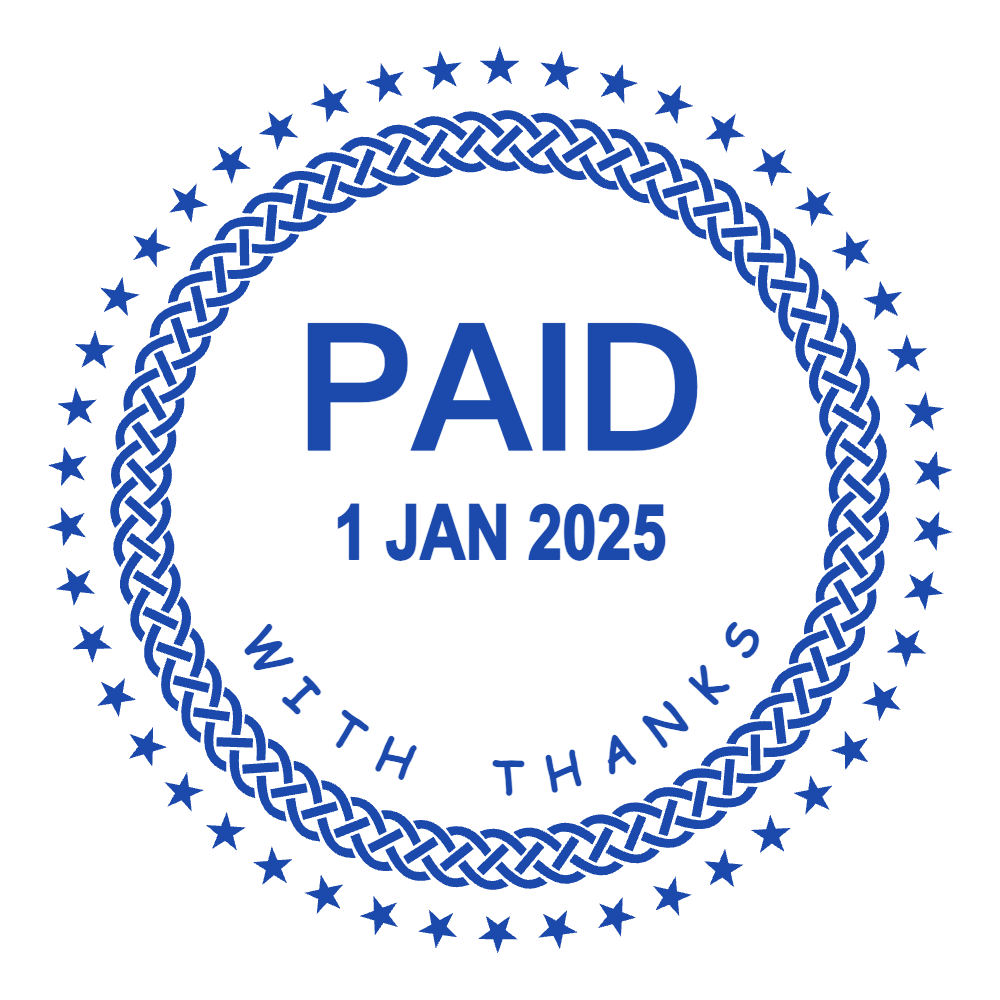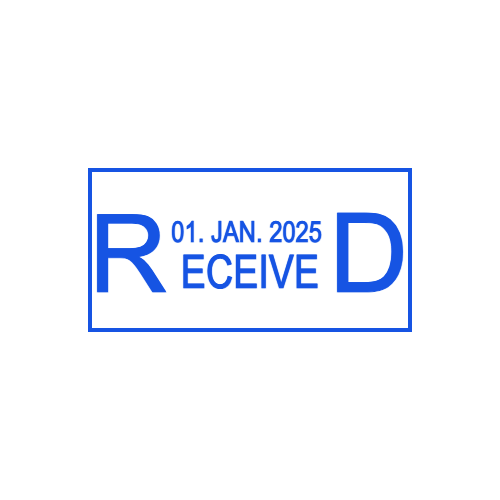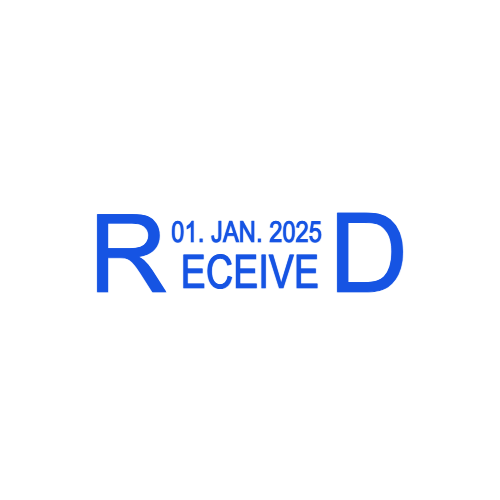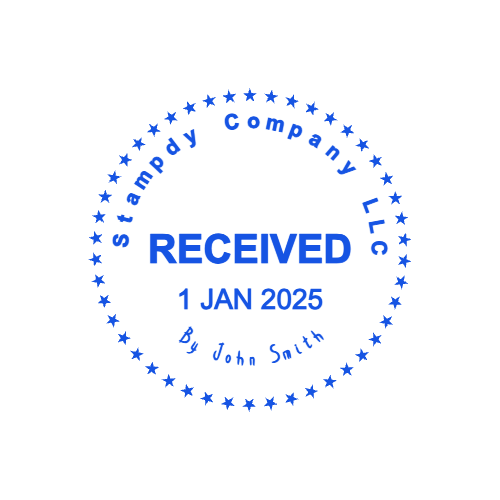Date Stamp Templates
Free editable date stamp templates for online editing
Found 6 date stamp Templates






Date Stamps: The Unsung Hero of Organized Documents—Uses, Types, and How to Choose One
If you’ve ever flipped through a stack of office papers, sorted invoices, or archived important records, you know how critical it is to track when a document was received, processed, or approved. That’s where date stamps come in—simple, reliable tools that add clear, consistent dates to paperwork in seconds. Unlike handwritten dates (which are messy, easy to misread, or prone to typos), date stamps create a uniform mark that eliminates confusion and keeps your workflow on track. Whether you’re running a small business, managing a medical office, or organizing personal files, a date stamp is a must-have for staying organized. Let’s break down everything you need to know about date stamps, from what they are to how to pick the right one for your needs.
What Is a Date Stamp, and Why Is It More Useful Than Handwriting Dates?
At its core, a date stamp is a specialized stamp designed to imprint a date onto paper, cardboard, or other materials. Most date stamps display the day, month, and year—but many also let you add extra text (like “Received,” “Approved,” or “Paid”) to make the stamp even more functional.
The biggest advantage of a date stamp over handwriting? Consistency. Think about it: if three different team members handwrite dates on invoices, you might end up with “08/27/25,” “27-08-2025,” and “Aug 27, 2025” in the same stack. This inconsistency can cause chaos later—say, when you’re trying to track which invoices were received in August versus July. A date stamp uses a standard format (you choose whether it’s MM/DD/YY, DD/MM/YYYY, or another style) so every date looks the same, no matter who uses the stamp.
Date stamps also save time. If you process 50 packages a day and need to date each delivery slip, handwriting each date would take minutes. A quick press of a date stamp does it in a fraction of the time—and reduces hand fatigue (a small win for anyone with a busy desk!). Plus, date stamps are more durable than pens: a good date stamp can last for years, while a pen runs out of ink or gets lost easily.
Who Needs a Date Stamp? (More People Than You Think!)
Date stamps aren’t just for offices—they’re useful in any setting where tracking time is important. Here are some of the most common users and how they rely on date stamps:
1. Small Business Owners & Office Managers
For small businesses, date stamps are a lifeline for keeping track of daily operations. Here’s how they’re used:
- Invoicing & Payments: Stamping invoices with “Received” and the date lets you track when you got a bill (so you don’t miss payment deadlines) and “Paid” with the date to prove you settled the debt (critical for disputes).
- Package & Mail Handling: When packages or letters arrive, a date stamp marks the delivery date—so you can follow up if a client claims their order never arrived.
- Employee Paperwork: HR teams use date stamps on time sheets, onboarding documents, or leave requests to note when forms are submitted or approved. This creates a clear paper trail for audits.
Take a small online boutique, for example. Every time they receive a return, they stamp the package with “Returned on [Date]” and “Processed by [Name].” If a customer contacts them asking about their refund, the team can quickly look up the stamped date to see when the return was received—and follow up if there’s a delay.
2. Medical & Dental Offices
In healthcare, accuracy and timeliness are everything—and date stamps help maintain both. Medical offices use date stamps for:
- Patient Records: Stamping lab results, prescription refills, or visit notes with the date ensures that every entry in a patient’s file is chronological. This is crucial for tracking treatment progress (e.g., “Blood work received on 08/20/25—results normal”) or for legal purposes if there’s a medical dispute.
- Prescriptions & Referrals: Date-stamping prescriptions helps pharmacists verify that the order is current (not expired) and that referrals to specialists are timely.
- Supply Management: Stamping the date on medical supply deliveries (like gloves, syringes, or bandages) lets staff track expiration dates and avoid using outdated products.
Dental offices also rely on date stamps—for example, stamping “Next Cleaning: [Date]” on a patient’s after-visit summary to remind them (and the office) of their next appointment.
3. Libraries & Educational Institutions
Libraries are all about tracking borrowed items—and date stamps are essential for that. A librarian uses a date stamp to mark the “Due Date” on the inside of a book, so patrons know when to return it. They also stamp “Checked Out on [Date]” and “Returned on [Date]” in their log books to keep track of inventory.
Schools use date stamps too. Teachers might stamp homework with “Turned In on [Date]” to track late submissions, or administrative staff might stamp permission slips with “Approved on [Date]” to ensure they’re processed before a field trip. Universities even use date stamps on application materials—marking when transcripts or recommendation letters are received to stay on top of admission deadlines.
4. Legal & Financial Professionals
In law firms and accounting offices, documents are often time-sensitive—and date stamps create an official record of when things happen. Lawyers use date stamps on:
- Court Filings: Stamping the date a document is filed with the court ensures that it meets legal deadlines (missing a deadline can derail a case).
- Client Correspondence: Stamping letters or emails (printed for records) with the date they’re sent or received helps track communication history.
Accountants rely on date stamps for:
- Tax Documents: Stamping receipts, bank statements, or tax forms with the date they’re added to a client’s file ensures that all records are organized by tax year.
- Audit Prep: Date-stamped documents make audits easier—auditors can quickly verify that transactions were recorded in the correct period.
5. Individuals (Yes, Even for Personal Use!)
You don’t need a business to benefit from a date stamp. Individuals use them for:
- Organizing Personal Files: Stamping bills, bank statements, or insurance documents with the date you receive them helps you sort paperwork by month or year (no more digging through a pile to find that July utility bill).
- Crafts & Hobbies: Scrapbookers use small date stamps to mark the date of a photo (e.g., “Family Vacation—07/15/25”) or a memory. Collectors (like stamp or coin collectors) use date stamps to mark when they added an item to their collection.
- Gifting: A date stamp with “Gift from [Your Name]—[Date]” can be pressed onto gift tags or cards, adding a personal touch that the recipient will remember.
Types of Date Stamps: Which One Is Right for You?
Date stamps come in several types, each designed for different needs. The key differences are in how they’re refilled, how often they’re used, and whether they let you add extra text. Here’s a breakdown:
1. Self-Inking Date Stamps (The Most Popular Choice)
Self-inking date stamps are the workhorses of offices—they have a built-in ink pad that automatically reinks the stamp after each use. This means no separate ink pad to carry around, and no messy fingers.
Best for: Frequent use (20+ stamps a day), like in busy offices, medical practices, or libraries. They’re easy to use—just press and go—and they produce clean, consistent dates every time.
Pros: Mess-free, durable, fast to use. Most self-inking date stamps can make 10,000+ impressions before the ink pad needs to be replaced (replacing the pad is cheap and easy).
Cons: They’re slightly bulkier than rubber date stamps (but still compact enough for a desk drawer). Some models don’t let you change the date format (so make sure to pick one that matches your needs—MM/DD/YY vs. DD/MM/YYYY).
2. Pre-Inked Date Stamps (For High-Volume Use)
Pre-inked date stamps are similar to self-inking ones, but the ink is embedded directly into the stamp itself (not a separate pad). This makes them even more durable—they can make 50,000+ impressions before needing a refill.
Best for: Very high-volume use, like in large warehouses (stamping delivery slips all day) or busy accounting firms (stamping hundreds of receipts a week). They’re also great for people who want a sleek, low-profile stamp (they’re thinner than self-inking models).
Pros: Long-lasting, no ink pad to replace (just refill with ink when it runs out), produces crisp impressions.
Cons: More expensive upfront than self-inking stamps. Refilling the ink requires a specific type of ink (you can’t use regular stamp ink), so you’ll need to buy refills from the same brand.
3. Rubber Date Stamps (For Occasional Use)
Rubber date stamps are the traditional option—they have a rubber die with the date (and optional text) and require a separate ink pad.
Best for: Occasional use (fewer than 10 stamps a day), like individuals organizing personal files or small businesses with low paperwork volume. They’re also the most affordable option.
Pros: Cheap, lightweight, easy to find (you can buy them at most office supply stores). You can switch ink colors easily by using a different ink pad (great for color-coding—e.g., red for “Late,” blue for “On Time”).
Cons: Require a separate ink pad (easy to lose or forget). You have to press the stamp into the ink pad before each use, which takes extra time. Smudges are more common if the ink pad is too wet.
4. Adjustable vs. Fixed-Date Stamps
Another key distinction is whether the date is adjustable or fixed:
- Adjustable Date Stamps: These are the most common type—you can change the day, month, and year by turning small dials on the stamp. This is perfect for everyday use, as you don’t need a new stamp every day.
- Fixed-Date Stamps: These stamps have a single, unchangeable date. They’re rare for regular use but useful for one-time events—like a conference where you need to stamp “Conference Date: 09/15/25” on all attendee badges.
Many date stamps also let you add custom text (called “dater with text” stamps). For example, you can get a stamp that says “Received: [Date]” or “Approved by: [Your Name] — [Date].” This adds extra functionality, as the stamp does more than just mark the date—it tells you what happened on that date.
How to Choose the Perfect Date Stamp (5 Key Factors)
With so many options, picking the right date stamp can feel overwhelming—but it’s easy if you focus on these five factors:
1. How Often Will You Use It?
- Frequent use (daily, 20+ stamps): Go with a self-inking or pre-inked date stamp. They’re faster and more durable.
- Occasional use (a few times a week): A rubber date stamp is fine—it’s cheap and gets the job done.
2. What Date Format Do You Need?
Make sure the stamp uses your preferred date format. For example:
- If you’re in the U.S., you’ll probably want MM/DD/YYYY (e.g., 08/27/2025).
- If you’re in Europe, Asia, or most other parts of the world, you’ll likely need DD/MM/YYYY (e.g., 27/08/2025).
- Some stamps let you choose between formats—look for “adjustable format” models if you’re unsure or work with international clients.
3. Do You Need Extra Text?
Ask yourself: Do I want the stamp to say more than just the date? If yes, get a “dater with text” stamp. Common text options include:
- “Received”
- “Approved”
- “Paid”
- “Processed”
- “Confidential”
- Custom text (like your name or business name)
Keep the text short—too many words will make the date hard to read. Most stamps can fit 1-2 short lines of text above or below the date.
4. What Size Stamp Do You Need?
Think about where you’ll be stamping:
- Small spaces (envelopes, invoice corners): A 1-inch to 1.5-inch date stamp is perfect—anything bigger will crowd the space.
- Large documents (shipping boxes, lab reports): A 2-inch to 2.5-inch stamp will be more visible.
Most date stamps are compact (about the size of a small marker), so they fit easily in a desk drawer or pencil cup.
5. What Ink Color Do You Prefer?
- Official documents (invoices, legal papers): Black or blue ink is best—they’re professional and easy to read.
- Color-coding (e.g., late vs. on-time): Red ink for “Late” or “Urgent,” green for “Approved,” or blue for “Received.”
- Crafts or personal use: Bright colors (pink, purple, orange) are fun and add personality.
Self-inking and pre-inked stamps usually come in black, blue, or red—but some brands offer other colors. Rubber date stamps let you use any ink pad color, so they’re more flexible for color choices.
Tips for Using and Maintaining Your Date Stamp
A well-maintained date stamp will last for years. Here’s how to keep it in top shape:
For Self-Inking and Pre-Inked Stamps:
- Clean it occasionally: Wipe the stamp surface with a damp cloth (no soap!) to remove ink buildup. This prevents smudges.
- Replace ink pads/refill ink on time: If the date starts to look faint, replace the ink pad (for self-inking) or add a few drops of refill ink (for pre-inked). Don’t overfill pre-inked stamps—too much ink causes smudges.
- Store it properly: Keep it in a cool, dry place (avoid direct sunlight or heat, which can dry out the ink). Don’t leave it pressed down (this can damage the ink pad).
For Rubber Date Stamps:
- Use the right ink pad: Make sure the ink pad is the same size as the stamp—too small, and the date will be incomplete; too big, and ink will get on the stamp handle.
- Don’t press too hard: Pressing firmly enough to get a clear impression is fine, but pressing too hard can damage the rubber die.
- Clean the rubber: If ink dries on the rubber, gently wipe it with a cotton swab dipped in rubbing alcohol (this dissolves dried ink without damaging the rubber).
Final Thoughts: Why a Date Stamp Is a Small Investment with Big Returns
A date stamp might seem like a simple tool, but it has a big impact on organization and efficiency. It eliminates the chaos of handwritten dates, saves time on administrative tasks, and creates a clear paper trail for important documents. Whether you’re a business owner trying to stay on top of invoices, a teacher tracking homework, or an individual organizing personal files, a date stamp makes your life easier.
And the best part? Date stamps are affordable. A basic rubber date stamp costs just $5-$10, while a high-quality self-inking one is $15-$30. Compare that to the time you’ll save (or the mistakes you’ll avoid) and it’s a no-brainer investment.
If you’re ready to upgrade your workflow with a date stamp, start by thinking about your needs: How often will you use it? Do you need extra text? What date format do you prefer? Once you have those answers, you’ll find the perfect date stamp in no time—and wonder how you ever lived without it.